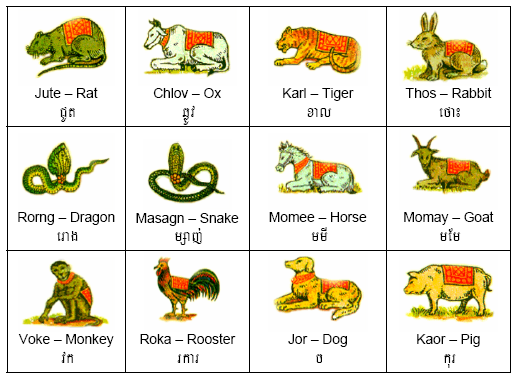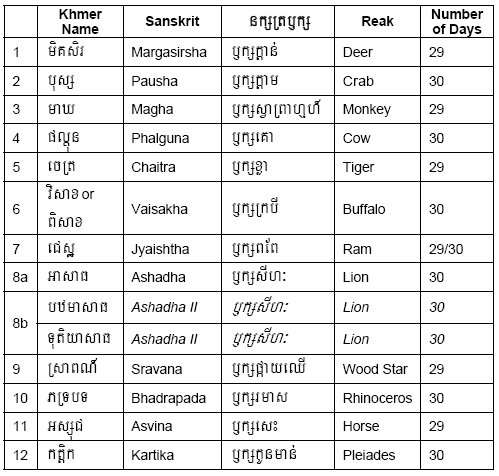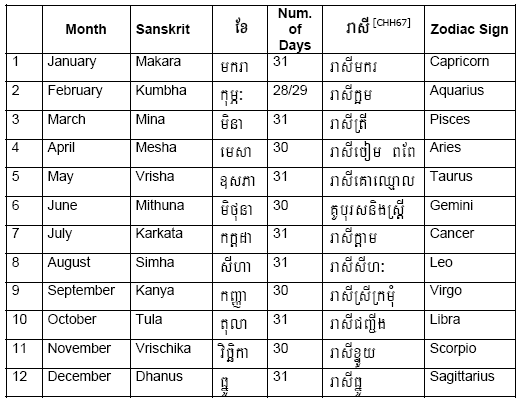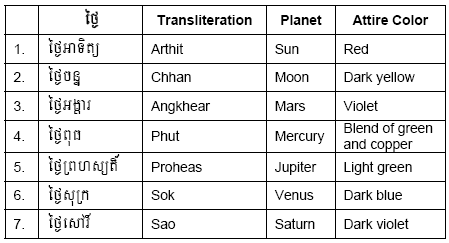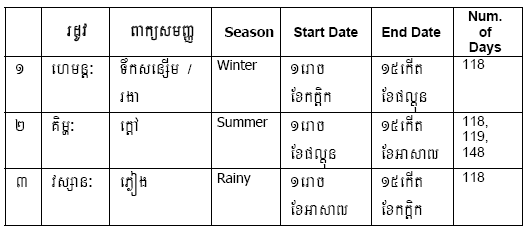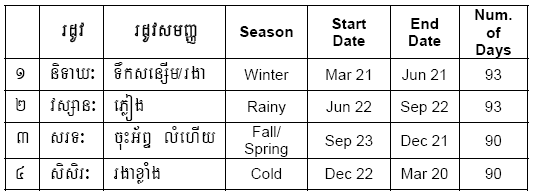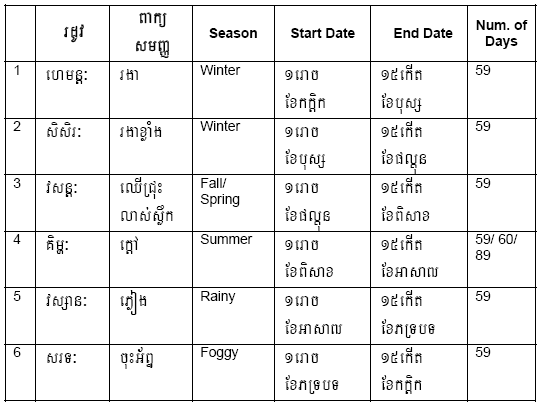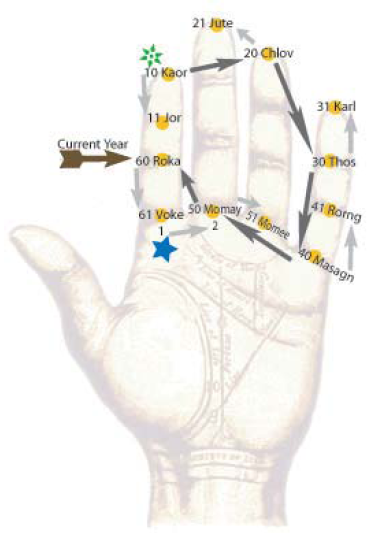Appendix
Years
Cambodians use both Sak and animals to reckon the year. Below is a table of animal years and Saks with corresponding years in different eras.
Sak
Calculating Sak from different eras
From Jolak Sakaraj, take a modulus of the year by 10 and the remainder is the Sak. If the remainder is 0, then it implies 10. For example: 2004 AD is 1366 JS. So 1366 mod 10 is 6 which is Chor Sak.
From BE, subtract the year by two then take the modulus of 10. The result is the Sak number just like above. For example in 2004 AD, the BE is 2548. So (2548 - 2) mod 10 is 6 which is Chor Sak.
Finding an animal year from a given era
For BE, the year 1 BE starts as Masagn (year of the snake). To find the animal year, add 5 to BE and take a modulus of 12. The result is the index number of an animal year. For example: For 2004 AD, 2548 BE + 5 is 2553. Then 2553 mod 12 is 9. The ninth animal is Voke (Monkey).
Jolak Sakaraj starts the first year as Koar (year of the pig). To find the animal year, add 11 to the era then take a modulus of 12. The result is the index number of an animal. For example: For 2004 AD, 1366 +11 is 1377. Then 1377 modulus 12 is 9. Voke (Monkey) is the 9th animal.
Animal
Below is a list of common Khmer art that represent the 12 animals.
Months
1.Lunar Month
Khmer lunar months are represented using Reak. According to Horas, Reak is group of star constellations that represent each month. Below is a list of lunar months with corresponding Reaks and the number of days.
2.Solar Month
Khmer solar month corresponds to western zodiac symbols. A year is divided into 12 Reaseys. Reasey is the measurement of the path of the sun and the moon that is divided into 30 degrees each. Below is a list of months and its meaning
Days of the Week
The table below shows the day of the week and its corresponding planets or celestial bodies. Color for Khmer traditional attire for each day of the week is also listed.
Seasons
1.Lunar Season ( )
)
This season is based on the lunisolar calendar. There are only 3 seasons defined per year. [CHH67]
2.Solar Season
There are four seasons based on the solar calendar. [CHH67]
3.Ancient Season ( )
)
The ancient seasons are not used today but it is shown here as a reference. There are 6 ancient seasons. [CHH67]
Traditional Ways of Counting Age
An animal year can be traced from one's age or vice versa. The tradition methods typically uses fingers to count with specific instructions.
1.Find your age from the animal year
This assumes that you have some idea of how old you are in a range of 10 years. Use the table on the right to determine the number to count for a specific age.
- Use your multiple of ten of your age to determine the count. Example, for the age around 30, the count is 6.
- Start from your birth animal year and count to the successive animal year for the number of time found in step 1. Example, assume I was born on the year of Dog (Jor) and I am around 30. So I would count 6 times as Kaor, Jute, Chlov, Karl, Thos, and Rorng. Notice I didn’t count Jor as 1 but count Kaor instead.
- Now use your finger to keep track of the count, and continue until you reach the current year. The final count is added to your multiple of ten number of your age. Example: Continue from step 2, I would count, Masagn as 1, Momee as 2, Momay as 3, Voke as 4, and Roka as 5. If the current year is Roka, then I stop here. There so I am 30 + 5 or 35 years old.
Example for birth year of Jor and assume this year is Roka:
2.Find animal year from your age [C4]
The 12 orange dots are the different positions used in this method. The animal years are positioned for the year of Roka (2005). This varies from year to year. The current animal year starts at "Current Year" arrow (second knuckle of the pointing finger) and counts clockwise to the successive years. The flower star is where you start if the age is at least 10 years old or else start at the blue star marked as 1 going counter clockwise up to 9.
- Assume you are older than 9 years old, start counting from the tip of the pointing finger (flower star) clockwise every second position. You count just the multiple of ten such as 10, 20, 30, and 40 until it reaches a multiple of ten of a specific age. As an example, for 35, I would count 10, 20, and then 30.
- If the age is a multiple of ten, that was your final position. Else, count from the current position by backward (counter clockwise) one position at a time until it reaches a specific age. So for the 35, from my early position, I count counter clockwise 31, 32, 33, 34, and then 35 arriving at the dot marked "11 Jor".
- The last step is to determine what animal belongs to that final position. For 2005, the animals are already marked. For a different ear, start counting the current year animal at the brown arrow *. Count clockwise until it reaches your final position. That is the birth animal year for that age.
* Notes: This method has been modified. The original method is to start positioning the year at the five-star (lowest point of the pointing finger). But this missed by one year; so to make it works I move the start position up to the Current Year arrow.
Religious Events
Here is a list of common Khmer religious day based on [C4]. Many of these are holidays in Cambodia but some are not.
- Meak Bochea (មាឃបូជា) : 15 Keit of Meak (Magha). A celebration of the Meak month to remember the monks meeting representing 4 different entities.
- New Year (ចូលឆ្នាំថ្មី ): This does not base on lunar calendar. Cambodian New Year celebration occurs on April 13 or 14 to April 15 or 16. This occurs no earlier than 4 Keit of Chait and no later than 4 Keit of Visak (Vaisakha). It is one of the biggest holiday celebrations.
- Pisak Bochea (ពិសាខបូជា): 15 Keit of Visak/Pisak (Vaisakha). The offering of the month Visak. This is a celebration of the birthday of Lord Buddha.
- Jole Preah Vosa (ចូលព្រះវស្សា): Occurs on 1 Roja of Ashad or 1 Roaj Thutiyasadh for leap-month year. This signifies the entering into the rainy season.
- Jegn Preah Vosa (ចេញព្រះវស្សា or ចូលវស្សា): Occurs on 15 Keit of Asuj. It means the end of the rainy season.
- Kann Ben 1st -14th (កាន់បិណ្ឌ): Occurs on 1 Roaj to 14 Roaj of Phutrobot. This is the commemoration of the spirits of the dead. The commemoration takes place in the temple from day 1 to day1 4. It is also known as Dak Ben.
- Pjum Ben (ភ្ជុំបិណ្ឌ): After the day 14 of Kann Ben, on 15 Roaj of Badrapadha, Pjum Ben occurs. It means the combination of all Ben or commemoration of the spirits of the dead.
- Kathin (កឋិន): Occurs on the day after Jegn Preah Vosa on 1 Roaj of Asuj. The festival centers on the temple to give offering to the monks.
- Sompeas Preah Khae (សំពះព្រះខែ): Occurs on 15 Keit of Kardek. This is a traditional celebration since the ancient time. It means to give respect to the moon.
Khmer Terminologies
- Adhikameas: (អធិកមាស): A leap year with extra month. The month of Ashad becomes two months: Badhamasad and Thutiyasad) with 30 days each. This leap-month year has 384 days compare to a normal 354-day year.
- Adhikavereak: (អធិកវារៈ): A leap year with extra day. Jays has 30 instead of 29. The Adhikavereak year has 355 days. This is also known as Chhantrea Thimeas.
- Ashad Thum (អាសាធធំ): Translated as big Ashad. This is a common term for Adhikameas. See Adhikameas.
- Ashad Toch (អាសាធតូច): It is translated as small Ashad. It refers to a non-leap year where Ashad month is a single month.
- Ayun Songkran (អាយន្ដសង្ក្រាន្ត): New Year (Songkran date) calculation using lunar (lunisolar) calendar system.
- Buddhist Era (ពុទ្ធសករាជ) (BE): Era started when Buddha passed away at the age of 80 on 544 BC. To calculate the BE date from AD, add 544 years to AD date. The BE dates of well-documented historical events may be off by one year, since the CE and BE calendars start their years on different months (January and May, respectively). But for Cambodians, New Year starts in April and new BE year begins on the Laeung Sak day of the New Year. Thai calculates BE year differently. Thai adds 543 instead of 544 to get Thai BE equivalents. [ANT00]
- Chhankitek (ចន្ទគតិ): This translated to lunar calendar which is a type of calendar that is based on the movement of the Moon. But Khmer calendar is actually lunisolar calendar, which based on the moon movement and also based on the synchronization with solar calendar.
- Chhantrea Thimeas (ចន្ទ្រាធិមាស): A synonym for Adhikavereak. See Adhikavereak.
- Jolak Sakaraj (ចុល្លសករាជ): An era that is assigned by King Botum Suriyeakvong (RBHbTumsuriyvgS ) to start on 1183 BE. To find this era from BE, subtract 1183 from BE year. This is also known as small Sakaraj (sakaraj toch).
- Keit (កើត): A naming of days in the Khmer calendar that counts from the first day of the month to next 15 days. It counts as 1 Keit, 2 Keit, to 15 Keit. These days fall in the waxing state in the lunar phase. It is from the new moon to the full moon.
- Kneit (ខ្នើត): The state of Keit or being in the phase of the moon waxing. It is from the new moon to the full moon.
- Leark Kae (លើកខែ): Common term for leap-month year or Adhikameas.
- Leark Tgnai (លើកថ្ងៃ): Common term for leap-day year or Adhikavearak.
- Moha Sakaraj (មហាសករាជ) An era based on 78 AD. It is supposedly started by the Shakas and adopted by the King Kanishka. The National Calendar of India uses this era and it is called Saka Era (78 AD = 0 Saka). So to find Saka, subtract 78 from AD. Khmer source indicates that the King Ketumalea (RBHektumala ) adopted the era 1 Saka = 621 BE. The assignment seems to have inconsistency. To find Moha Sakaraj, subtract 622 from BE. Moha Sakaraj also known as big Sakaraj and Jolak Sakaraj is known as small Sakaraj.
- Moha Songkran (មហាសង្ក្រាន្ត): The predictions that are made by the Horas about the coming year. The prediction includes astronomical events such as eclipse, the cultural prediction of the New Year angels, and other overall prediction of the year.
- Roaj (រោច): The naming of day in the Khmer calendar that count from the 16th day of the month to end of the month. It counts as 1 Roaj, 2 Roaj, to 14 or 15 Roaj depending on the month. These days fall in later half of the month after the first 15 days of Keit. This is in the waning state of the lunar phase. It starts from the full moon to the new moon.
- Ronoch (រនោច): The state of Roaj or the state of the moon waning phase. Waning state starts from the full moon to the new moon.
- Sak (ស័ក): Sak means year. Sak system uses the Sanskrit words to imply the number 1-10 with the word Sak added to the end. These unique words are used to reckoning the year with the animals years. This forms a 60-year cycle.
- Sakaraj Thom (សករាជធំ): It translates to "big Sakaraj". A common term for Moha Sakaraj. See Moha Sakaraj.
- Sakaraj Toch (សករាជតូច): It translates to "small Sakaraj". A common term for Jolak Sakaraj. See Jolak Sakaraj.
- Samagn Songkran (សាមញ្ញសង្ក្រាន្ត): New Year (Songkran date) calculation using the solar calendar.
- Songkran (សង្ក្រាន្ត): The time that the Sun enter the Mesa Reasey from Mena Reasey. It is the New Year day. It is on April 13 or 14 in Gregorian calendar.
- Soriyeakitek (សុរិយគតិ): A type of calendar that is based on the movement of the Sun. The international calendar or Gregorian calendar is a solar calendar.
- Tgnai Kaor (ថ្ងៃកោរ): The day that the monks shave. This falls on 14 Keit and one day before the end of each month (either 13 or 14 Roaj).
- Tgnai Pegnboramei (ថ្ងៃពេញបូណ៌មី): The full moon day which occurs on 15 Keit of each month. This happens when the Moon is on the opposite side of the Earth and the Sun.
- Tgnai Sel (ថ្ងៃសីល): Holy day in the Buddhist religion. The day is set to be on 8 Keit, 15 Keit, 8 Roaj, and the last day of Roaj.
- Tngai Laeung Sak (ថ្ងៃឡើងស័ក): the day to increment Sak which is the last day of the New Year celebration.
- Tgnai Songkran (ថ្ងៃសង្រ្កាន្ត): day of the Songkran. See Songkran.
- Tngai Vonobot (ថ្ងៃវ័នបត): the second day of the New Year celebration.


